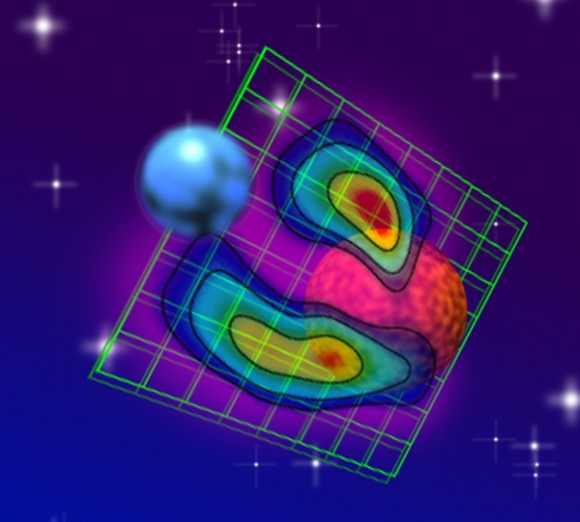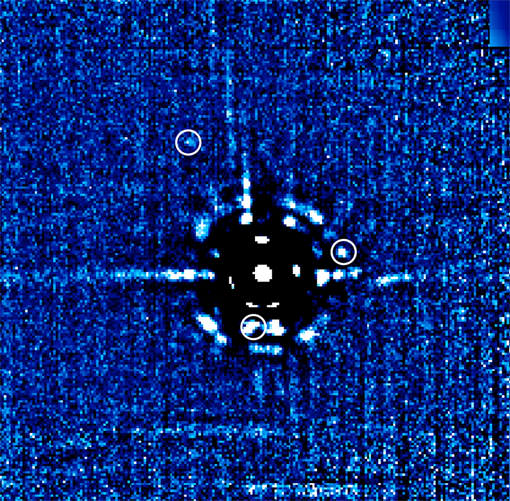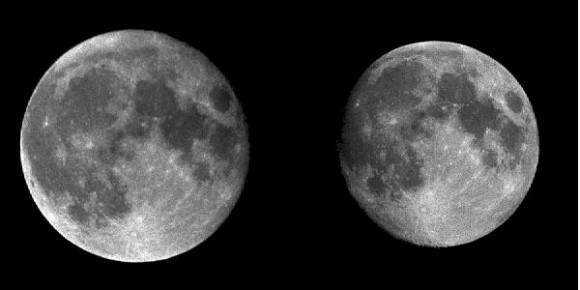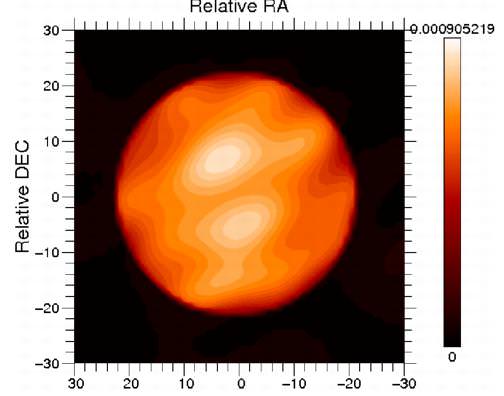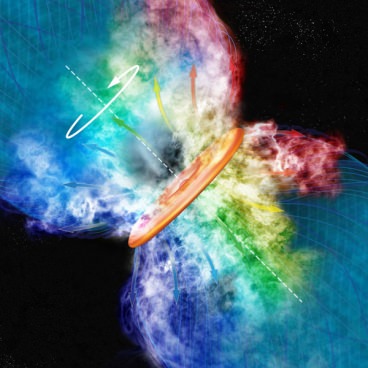Giant Magnetic Loop Stretches Between Two Stars
Using a collection of radio telescopes, astronomers have found a giant magnetic loop stretched outward from one of the stars making up the famous binary star system Algol, located in the constellation Perseus. "This is the first time we've seen a feature like this in the magnetic field of any star other than the Sun," said William Peterson, of the University of Iowa.
(...)
Read the rest of Giant Magnetic Loop Stretches Between Two Stars (300 words)
First Direct Spectrum of an Exoplanet Orbiting a Sun-like Star
Astronomers have obtained the first direct spectrum – a “chemical fingerprint” – of a planet orbiting a distant, Sun-like star, providing direct data about the composition of the planet's atmosphere. An international team of researchers studied the planetary system around HR 8799 a bright, young star with 1.5 times the mass of our Sun, and focused on one of three planets orbiting the star. While the results were unusual and pose a challenge to current models of the exoplanet's atmosphere, the accomplishment represents a milestone in the search for life elsewhere in the Universe.
(...)
Read the rest of First Direct Spectrum of an Exoplanet Orbiting a Sun-like Star (488 words)
Measuring the Moon's Eccentricity at Home
Caption: View of the moon at perigee and apogee
As a teacher, I'm always on the lookout for labs with simple setups appropriate for students. My current favorite is finding the speed of light with chocolate.
In a new paper recently uploaded to arXiv, Kevin Krisciunas from Texas A&M describes a method for determining the orbital eccentricity of the moon with a surprisingly low error using nothing more than a meter stick, a piece of cardboard and a program meant for fitting curves to variable stars.
(...)
Read the rest of Measuring the Moon's Eccentricity at Home (494 words)
Unprecedented Images Show Betelgeuse Has Sunspots
Caption:The surface of Betelgeuse in near infrared at 1.64 micron in wavelength, obtained with the IOTA interferometer (Arizona). The image has been re-constructed with two different algorithms, which yield the same details, of 9 milliarcseconds (mas). The star diameter is about 45 milliarcseconds. Credit: Copyright 2010 Haubois / Perrin (LESIA, Observatoire de Paris)
An international team of astronomers has obtained an unprecedented image of the surface of the red supergiant Betelgeuse, in the constellation Orion. The image reveals the presence of two giant bright spots, which cover a large fraction of the surface. Their size is equivalent to the Earth-Sun distance. This observation provides the first strong and direct indication of the presence of the convection phenomenon, transport of heat by moving matter, in a star other than the Sun. This result provides a better understanding of the structure and evolution of supergiants.
(...)
Read the rest of Unprecedented Images Show Betelgeuse Has Sunspots (536 words)
Dark Energy Model Explains 'Hubble Sequence' of Galaxies
Caption: A figure illustrating the Hubble sequence. Image: Ville Koistinen
One look at a Hubble Deep Field image reveals that galaxies come in all sorts of shapes and sizes. But why? Astronomers have been at a loss to explain the diversity of galaxy shapes seen in the Universe. But now, two astronomers have tracked the evolution of galaxies over thirteen billion years from the early Universe to the present day, helping to clarify the "Hubble Sequence," a classification of galaxies developed by Edwin Hubble. Keys to their model include galaxy mergers and dark energy.
(...)
Read the rest of Dark Energy Model Explains 'Hubble Sequence' of Galaxies (519 words)
Time-Lapse Movie Shows Massive Stars Form Similarly to Smaller S
It has been difficult for astronomers to see how massive stars form, since these stars are rare, form quickly and tend to be enshrouded in dense, dusty material which obscures them from view. But astronomers using the Very Long Baseline Array (VLBA) radio telescope were able to take images of the wavelengths of light emitted by a massive young star located 1,350 light years away in the Orion constellation. The created a 'movie' from the data, which they say shows the first evidence that young massive stars form from an accretion disk, just as smaller stars form.
(...)
Read the rest of Time-Lapse Movie Shows Massive Stars Form Similarly to Smaller Stars (464 words)
Vyugovey – The Real "Ice In Space"
Ain't no doubt about it… Space is cool! And this year Russian space exploration is not only cool – but ice cold. This year’s International Festival of Snow, Ice and Light sculptures “Vyugovey” will take place in Moscow from December 25 to February 28 in the Memorial Museum of Space Exploration {ark on Prospekt Mira, and is devoted to the 50th anniversary of Russian space exploration. (...)
Read the rest of Vyugovey – The Real "Ice In Space" (298 words)
STS-130 Shuttle flight facing delay due to Payload technical gli
Caption: Overhead view of Tranquility & Cupola modules inside the Space Station Processing Facility at Kennedy Space Center on Jan 8, 2010. Tranquility will be attached to ISS by STS 130 astronaut crew. Credit: Ken Kremer
(Editor's Note: Ken Kremer is in Florida for Universe Today covering the pre-launch activities of Endeavour.)
The launch of Shuttle Endeavour on the STS 130 flight now faces a potential delay due to technical problems with the external ammonia connecting lines which are designed to provide critical cooling capability to the new Tranquility module. Tranquility is a pressurized module being brought aloft as payload in the cargo bay of Endeavour on the STS 130 mission. Launch of Endeavour is currently set for 4:39 AM on Feb. 7.
(...)
Read the rest of STS-130 Shuttle flight facing delay due to Payload technical glitch (686 words)
More Saturn System Beauty from Cassini
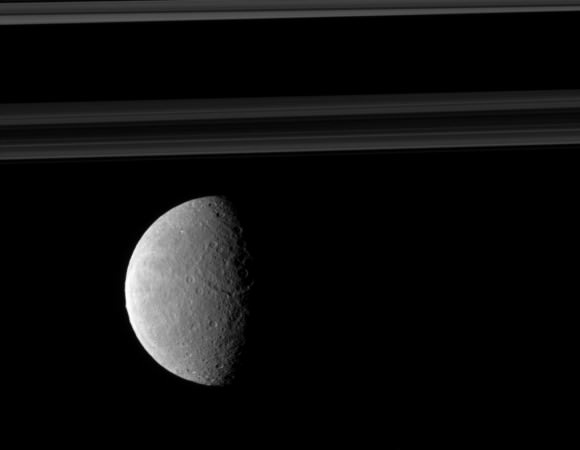
Caption: Cassini captures Rhea and Saturn's rings. Credit: NASA/JPL/Space Science Institute
The stunning images just keep coming from Cassini. Here's a collection of three recent images. Above, Saturn's moon Rhea teams up with the planet's rings, creating an image that could only come from the Saturn system. Taken on Nov. 4, 2009, Rhea's trailing hemisphere shows off its wispy terrain. The view was acquired at a distance of approximately 762,000 kilometers (473,000 miles) from Rhea, with the rings farther away, off in the distance.
(...)
Read the rest of More Saturn System Beauty from Cassini (243 words)
Weekend SkyWatcher's Forecast – January 8-10, 2010
Greetings, fellow SkyWatchers! While the skies don't change a whole lot from year to year, how you approach astronomy and what you can do with your "astronomy time" certainly does! We begin the weekend with a variable star and a great galaxy. Ready for more? Then why not tackle an historic learning project with Mars? No scope or binoculars? No problem. There's still lots of cool things you can do when you know where to look! Whenever you're ready, I'll see you in the backyard….(...)
Read the rest of Weekend SkyWatcher's Forecast – January 8-10, 2010 (1,890 words)
NASA Science News for January 8, 2010 10:00:00 AM
Most astronomers wouldn't dream of opening their observatory's doors in 100 mph winds. Yet NASA's new SOFIA telescope recently flew in an airplane at 250 mph with doors wide open. The successful test is an important step forward for infrared astronomy.
FULL STORY at
http://science.nasa.gov/headlines/y2010/08jan_flyingtelescope.htm?list1035898
Supernova Simulations Point to White Dwarf Mergers
Type Ia supernovae, some of the most violent and luminous explosions in the Universe, have become a handy tool for astronomers to measure the size and expansion of the Universe itself. Because they explode with a rather specific peak luminosity, they can be used as "standard candles" to measure distances. New research presented at the American Astronomical Society meeting this week points to the increased likelihood that the mergers of the stars that create these explosions, white dwarfs, is more likely than previously thought, and could explain the properties of some Type Ia supernovae that are curiously less luminous than expected.(...)
Read the rest of Supernova Simulations Point to White Dwarf Mergers (460 words)
Another Antimatter Supernova Discovered
Here's another extremely explosive supernova that can be chalked up to the production of antimatter in the core of the star: Y-155. These types of supernova explosions – which can be ten times brighter than the already spectacular explosion of a Type Ia supernova – have been theorized to exist for over forty years. About a month ago, we reported on the first observations of one of these types of supernovae, and at the American Astronomical Society super-meeting yesterday, Peter Garnavich of the University of Notre Dame presented on the observation of a second.(...)
Read the rest of Another Antimatter Supernova Discovered (513 words)
Faster-Than-Light Pulsar Phenomena
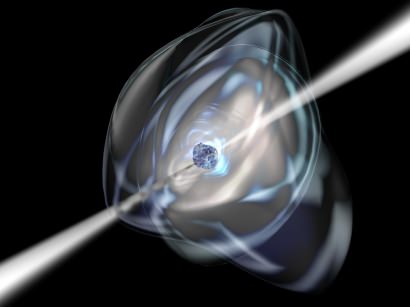
Observational data from nine pulsars, including the Crab pulsar, suggest these rapidly spinning neutron stars emit the electromagnetic equivalent of a sonic boom, and a model created to understand this phenomenon shows that the source of the emissions could be traveling faster than the speed of light. Researchers say as the polarization currents in these emissions are whipped around with a mechanism likened to a synchrotron, the sources could be traveling up to six times light speed, or 1.8 million km per second. However, although the source of the radiation exceeds the speed of light, the emitted radiation travels at normal light speed once it leaves the source. "This is not science fiction, and no laws of physics were broken in this model," said John Singleton of Los Alamos National Laboratory at a press briefing at the American Astronomical Society meeting in Washington, DC. "And Einstein’s theory of Special Relativity is not violated."
(...)
Read the rest of Faster-Than-Light Pulsar Phenomena (541 words)
Spitzer Peers Into the Small Magellanic Cloud
This week at the AAC Conference, astronomers released a new image of the Small Magellanic Cloud (SMC, a dwarf galaxy just outside our Milky Way) from Spitzer. The purpose of the image was to study "the life cycle of dust in this galaxy." In this life cycle, clouds of gas and dust collapse to form new stars. As those stars die, they create new dust in their atmosphere which will enrich the galaxy and, when the stars give off that dust, will be made available future generations of stars. The rate at which this process occurs determines how fast the galaxy will evolve. This research has shown that the SMC is far less evolved than our on galaxy and only has 20% of the heavy elements that our own galaxy has. Such unevolved galaxies are reminiscent of the building blocks of larger galaxies.
(...)
Read the rest of Spitzer Peers Into the Small Magellanic Cloud (194 words)
